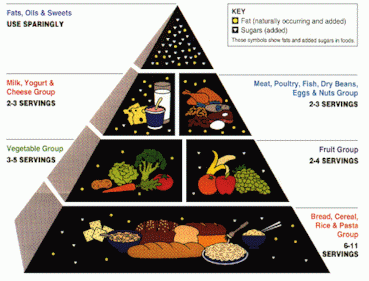|
Did the Faulty Food Guide Pyramid Make You Obese?
The Dietary Guidelines for America (DGA), which are
sponsored by the U.S. Department of Agriculture (USDA)
and make up the foundation of the Food Guide Pyramid,
are neither nutritionally or biochemically sound. In
fact, many experts now believe that the very principles
that were meant to be "heart healthy and beneficial
to all who followed them" may be responsible for
the epidemics of heart disease, type 2 diabetes and
obesity facing the nation. 
The principles are based on the "lipid hypothesis,"
developed in the 1950s by nutrition pioneer Ancel Keys,
that linked dietary fat to coronary heart disease--the
nutrition community of that time completely accepted
the hypothesis, and encouraged the public to cut out
butter, red meat, animal fats, eggs, dairy and other
"artery clogging" fats from their diets. This
was a radical change to the diets of tens of millions
of Americans.
Experts cite the following problems with the Dietary
Guidelines:
Protein is considered to be the least important macronutrient.
The fat-phobic recommendations lead to a critical deficiency
in saturated fat, an unnecessary limitation of dietary
cholesterol and an unhealthy ratio of omega-6 to omega-3
fatty acids.
The essential fatty acids are ignored.
An unhealthy excess of carbohydrates is recommended.
There is not enough of a recommendation to limit the
dangerous trans fatty acids.
The paper's authors acknowledge that it won't be easy
to change the "long-held beliefs that animal fats
cause cardiovascular disease and grain products are
the staff of life," but say that ignoring the science
that says otherwise is no longer an option. Further,
they point out that the 2005 changes to the DGA and
Food Guide Pyramid will make the guidelines more complex
but won't correct the errors.
Journal of the American Physicians and Surgeons, Winter
2004: 109-113 (Free Full-Text PDF)
|



